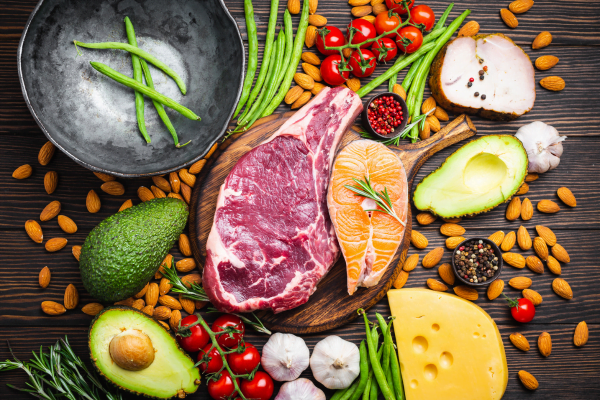The Paleo diet is a dietary approach that aims to mimic the eating habits of our ancestors from the Palaeolithic era. The paleo diet offers several benefits, including weight management, improved blood sugar levels, reduced inflammation, improved digestive health, and enhanced energy levels.
What is the paleo diet?
The paleo diet, often referred to as the stone age or caveman diet, is a way of eating that focuses on consuming wild foods that were popular in the Palaeolithic era. The Palaeolithic was the first stage of the stone age, which lasted for roughly 2.5 million years and recognised the usage of simple stone tools. The contemporary paleo diet attempts to imitate and modify the information regarding ancestors’ diets to fit the typical food groupings seen in Western nations.
How does the diet work?
The paleo diet aims to incorporate ideas from theories of evolutionary nutrition into a contemporary diet. There are no calorie restrictions and portion control. Protein and fat in the diet predominantly contribute to satiety.
The paleo diet includes a list of items that should be consumed or avoided
6 ground rules
- Lean meats and seafood are included in the diet.
- All types of fruits and non-starchy vegetables can be included
- None of the cereals must be included
- No legumes can be included
- No dairy products are allowed
- No processed foods are allowed
Lean meat and seafood
Lean meat, fish and seafood should account for only half of the daily calorie requirements. Due to the high-calorie content in eggs owing to the fat percentage, it is allowed to be consumed only 6 to 12 per week.
Fruits and vegetables
Fresh fruits can be taken without any restriction, unless a person is overweight or obese, it can be taken in limited quantities. Restriction of certain fruits that are high in sugars such as bananas, watermelon, grapes, cherries, and mango can be followed in individuals who are diabetic. Dried fruits are restricted to no more than 50g daily in case the individuals are trying to lose weight. Non-starchy vegetables can be eaten without any restrictions. In the old paleo diet, all starchy vegetables were avoided but in the modern diet, certain starchy vegetables such as potatoes and cassava are included in moderation due to their nutritional content.
The Paleo diet is described by Cordain as a bad-fat-free diet. Unsaturated fat can be eaten in moderation in the diet, the fat-rich foods include all nuts, avocado, and oils like olive oil and avocado oil. The main beverage of the paleo diet is water. Other beverages such as alcohol, coffee and tea are limited. Beverages containing artificial sweeteners, and natural sugars are avoided.
Micronutrients in the paleo diet
Vitamins and minerals are consumed according to the Recommended Daily Allowance (RDA). In some individuals, intake of micronutrient supplementation is advised due to not achieving the RDA through food. It is recommended to take antioxidant supplements to improve immune function and protect against cancer due to the diet containing toxic substances.
Snacks in the paleo diet
Snacks are included in the paleo diet, but they too follow the same rules as lean meats, fruits and non-starchy vegetables.
Foods that are avoided in the Paleo diet
- Any dairy products.
- Legumes like peanuts and soy.
- Starchy vegetables, including tuber varieties such as potatoes, sweet potatoes, tapioca, and yams.
- Salty foods such as salted spices, pickled foods, processed meats and condiments.
- Fatty meats.
- Sweetened beverages and fruit juice.
- Added sugars.
The adherence of the paleo diet
Open meals (no restrictions laid down by the paleo diet are followed) don’t stick to the guidelines of the paleo diet. The main aim is to be free from all the paleo diet restrictions and flexibility to sustain the diet for the long term. It should be limited to one open meal for a day so the meals are not overindulged and going off of the diet.
- Level 1 – Entry Level with three open meals per week
It is based on 85%-15%, where 85% of the plate food choices adhere to paleo diet restrictions and 15% of the plates do not adhere to paleo rules. 15% is the open meals, where the meals are flexible and free from restrictions.
- Level 2 – Maintenance level with two open meals per week
It is a maintenance level, where two open meals are allowed per week, it should not include transitional foods.
- Level 3 – Maximal weight loss level with one open meal per week
This level is for individuals who want to reap maximum benefit from a paleo diet, and those who suffer from chronic obesity and other diseases.
The benefits of the paleo diet
- Nutrient-dense diet
The diet emphasises whole grains, whole vegetables, fruits, nuts, and seeds. Consuming wholesome food has potential benefits. To achieve a balanced diet, it is important to plan and take into account one’s needs.
- Weight management
The diet avoids processed foods, refined carbohydrates, refined sugars, and grains. It emphasises whole foods therefore it helps in weight loss. This influence benefits humans by improving hormonal function by regulating appetite regulation and overall metabolic health.
- Blood sugar regulation
It helps regulate blood sugar levels, as the diet comprises foods of low glycaemic food. The diet eliminates refined sugars and emphasises whole foods, fibre-rich foods, and healthy fats. These contribute to improved insulin sensitivity, reduced inflammation, and elimination of anti-nutrients.
- Improved lipid profiles
The diet focuses on consuming healthy fats. Healthy fats such as avocados, nuts, seeds, and olive oil. The diet has a balanced omega 3 to 6 ratio and It reduces trans fat. This improves the cholesterol levels in the body.
- Increased protein intake
Animal protein such as poultry, fish, and eggs are included in the diet. The encouragement of lean protein intake improves the amino acid profile. Protein gives satiety and improves muscle strength.
- Reduced inflammation
Consuming a nutrient-rich diet and antioxidant-rich food helps in reducing inflammation. The diet also avoids gluten, lectins, and refined sugars, which helps in the reduction of inflammation.
- Improved gut Health
The intake of high-fibre-rich food from various plant food and prebiotic foods. Fibre helps in improving gut health.
The drawback of the paleo diet
- Nutrient deficiency
Following a paleo diet may lead to some nutrient deficiencies due to its restriction of certain foods. Some vitamin and mineral deficiencies such as vitamin D, iron, and magnesium can be found in individuals who follow a paleo diet.
- Limited food choices
The Paleo diet may be restrictive for certain groups such as –
- Vegetarians and vegans (exclusion of grains, legumes, and dairy may limit protein intake, making it difficult for vegetarians and vegans to meet protein needs).
- Individuals with nut allergies.
- Athletes
- Individuals with lactose intolerance.
- Individuals with cardiovascular conditions.
- Individuals from different cultural backgrounds.
- Individuals with kidney conditions or specific health conditions, such as gout or inflammatory bowel diseases.
- Cost and accessibility
The paleo diet can be expensive because it emphasises high-quality, organic food.
- Overemphasis on protein
The diet sometimes may over-emphasise the consumption of proteins. Excessive protein consumption may stress kidneys and cause imbalance, it may also affect gut health. It may also conflict with sustainable dietary practice due to its focus on animal protein. It is better to choose from diverse protein sources.
- Social limitation
This diet can sometimes limit social interaction in various settings, options include social events, dining out, and inconvenience in shared meals. The diet may not align with cultural beliefs or traditions.
- Complex and planning
This diet requires careful planning as the diet has restrictions. It is always better to plan meals and cooking techniques. Social dining requires planning as this diet is not one-size-fits-all.
- Rigid dietary framework
The diet has rigid guidelines and less flexibility. This lack of flexibility makes it less adaptable and easy to follow for a long time.
In conclusion, the paleo diet follows rigid guidelines and lacks flexibility. It has its pros and cons. It is advised to consult a professional dietitian before starting the diet.
Kripa N,
Senior Clinical Dietitian, Simplyweight





